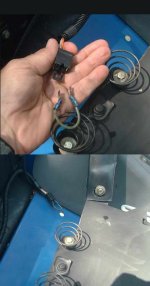JC, it appears that pins #1 and #3 may do the trick, but I'd like to know where the other white wire goes from pin #4. The function of the PTO safety is to say if the PTO is off and the tractor in neutral with the parking brake set, the operator can get out of the seat. The functions for this are in the operator safety module which must be on another page. Therefore, I would say that to be certain the seat switch is fully bypased, I would remove the connector from the seat and jumper 1 to 3 and also 2 to 4. That's what the switch does when it closes. We should replicate that as closely as possible.
In addition, I would try to make a jumper with pins similar to the ones in the plug like I did with my seat switch in the earlier picture. You want to bypass the switch, but make it so that all you have to do is disconnect the jumpers and plug the switch back in for normal operation. Being able to easily return to a normal configuration might be handy if you are taking your tractor in to have it serviced. If your dealer sees a bypass, he might consider that as putting himself at risk. Returning the switch to normal while the tractor is serviced would be my choice to remove any risk to the dealer's shop.




